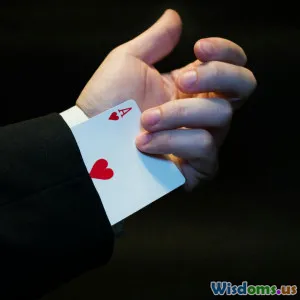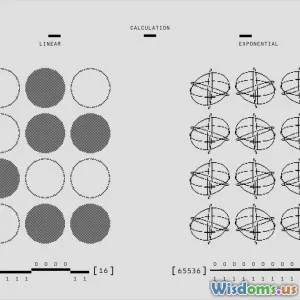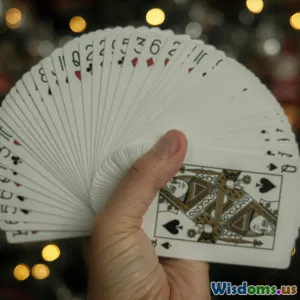
How Magicians Use Misdirection to Fool Your Brain
14 min read Discover how magicians expertly exploit misdirection to manipulate your perception and decode the fascinating psychology behind their astonishing illusions. (0 Reviews)
How Magicians Use Misdirection to Fool Your Brain
Magic, for centuries, has captivated, astounded, and confounded audiences. From grand stage illusions that leave us in slack-jawed wonder to nimble card tricks performed up close, the shared reaction is often the same: "How did they do that?" The answer isn’t always hidden in the dexterity of a magician’s hand but rather in the psychology guiding your own brain. The artful use of misdirection is the illusionist’s top tool—one that plays upon our hardwired attention, prediction, and memory systems. What exactly is misdirection, and how does it enable magicians to bend the apparent rules of reality?
The Curious Power of Misdirection
Legendary magician and escapologist Harry Houdini once quipped, "The real secret of magic lies in the performance." Likewise, celebrated illusionist Teller (of Penn & Teller) added, “Sometimes magic is just someone spending more time on something than anyone else might reasonably expect.” But time isn’t the only investment; understanding the science of human attention is just as essential. The principle of misdirection is simple: a technique wherein the performer draws the spectator's attention away from the method—or secret—behind a trick.
Yet, its application is profoundly intricate. Misdirection exploits the very mechanisms that help us interact with an overwhelmingly complex world. By leveraging bottom-up and top-down processes in your brain, magicians ensure you see what they want you to see—and, crucially, that you miss what they don’t.
1. The Neuroscience of Attention: Your Brain’s Gatekeeper
Selective Attention: Brain Filters at Work
Our senses are bombarded by over 11 million bits of information every second, yet we consciously process just a fraction. The rest is filtered out. Neuroscientist Dr. Susana Martinez-Conde, who has studied magic’s effects on the brain, explains, "Our brain has to be selective. Otherwise, it would be overwhelmed and paralyzed by information overload."
Selective attention means some stimuli are prioritized over others—think of focusing on a friend during a noisy party (the so-called ‘cocktail party effect’). Magicians use this filtering to their advantage, guiding your focus away from their secret maneuvers.
Example: The Vanishing Ball Illusion
Psychologist Alfred Binet first studied magic tricks to better understand attention. In the classic vanishing ball trick, a magician tosses a ball in the air a few times, then pretends to throw it on the last go. A large proportion of the audience reports seeing the ball vanish mid-air, when in fact, it was never thrown at all. Instead, the performer’s eyes and gestures draw your gaze upward; your brain predicts the ball’s path—then fills in the blanks with false perception.
Inattentional Blindness: Seeing, Yet Not Seeing
The famous “invisible gorilla” experiment by Christopher Chabris and Daniel Simons revealed that people can overlook surprisingly obvious events when their attention is focused elsewhere. The study, in which viewers failed to notice a person in a monkey suit walking through a group passing basketballs, mirrors how magicians make objects—or even people—disappear right before our eyes.
In magic, this is deliberate. Magician Apollo Robbins, known as “The Gentleman Thief,” says, “Attention is like a spotlight. There are things that fall into the perimeter of our awareness that we never see because our minds are elsewhere.”
2. The Types of Misdirection: More Than Meets the Eye
There is no single way magicians utilize misdirection—it is a toolkit of strategies, each engaging unique quirks of our perception.
a. Physical Misdirection: Directing the Senses
Physical signals—gaze direction, hand gestures, posture—are among a magician’s most reliable tools.
Example: Derren Brown’s Psychological Subtlety
British illusionist Derren Brown employs a technique called "cueing." If he wants the audience to focus on a particular object, he might glance at or gesture toward it. This alone is often enough to steer attention, especially if it’s coupled with a sudden movement or audible snap.
b. Temporal Misdirection: Exploiting the Timeline
Diverting attention at a key moment—rather than a location—is another method.
The Delayed Reveal
Famed magician Lance Burton demonstrated this by performing a flourish, then pausing and joking with the audience—only to later ‘find’ a bird under an apparently empty handkerchief.
c. Psychological Misdirection: Planting Thoughts and Assumptions
Words are potent tools for misdirection. By framing what the audience should expect, magicians can psychologically set the stage for a totally different reality.
The “False Solution” Trap
When David Copperfield invites a spectator onstage, he talks at length about one object—a curtain, for instance. The audience now assumes this is central, only to be sideswiped by the actual method, which involved something they weren’t even watching.
d. Misdirection by Perceptual Overload
Sometimes, magicians intentionally overwhelm your senses to decrease your capacity to process details.
Example: Penn & Teller’s “Cups and Balls”
During their famous cups-and-balls routine, they chat, joke, use unexpected props, and work together to manufacture confusion. Amidst the chaos, large objects appear under cups—objects that keen observers believe would be impossible to introduce undetected.
3. The Science Behind Why It Works
Our Brains Predict, Not Just Record
Renowned neuroscientist Dr. Stephen Macknik, co-author of Sleights of Mind, argues, “Vision is a construction of the brain. What you’re aware of isn’t everything coming in; it’s what your brain thinks is important.”
Instead of processing every detail, your brain anticipates outcomes based on previous experiences and cues.
Example: Prediction in Practice
When a magician pretends to transfer a coin from one hand to the other, the brain, seeing the actions it recognizes, predicts the coin’s new location—even when it remained unmoved all along. Research published in Nature Reviews Neuroscience (2010) shows that perception relies as much on expectation as actual sensory input.
Change Blindness: Missing Big Changes
Change blindness is the phenomenon where observers fail to notice major changes in a visual scene. Magicians rely on this—during a card trick, while you're focused on the cards, they can, for example, swap decks outright, and most audiences remain oblivious.
The Social Brain: Reading Intentions—and Being Fooled
Our brains are tuned to read other people’s intentions—a survival trait. Magicians use this by displaying overt intent with one hand while concealing crucial action with the other. For instance, if a magician looks intently at a particular area, our brains follow, anticipating this is where 'something important’ will happen. Meanwhile, the real action unfolds elsewhere.
4. Real-World Experiments: When Magic Meets Science
Labs and Magic Collide
Researchers collaborate with professional magicians to study the mechanics of misdirection. Dr. Gustav Kuhn, a cognitive psychologist and former magician, frequently uses magic in experiments.
The Cup Switch Example
A Kuhn-led study involved a simple trick: switching a cup while participants’ eye movements were tracked. Although most looked directly at the switch, only 11% reported noticing it—our brain simply filed the information away as unimportant.
Brain Scans: A Glimpse Behind the Curtain
Modern imaging techniques (like functional MRI) show that tricks triggering surprise or acts of misdirection create activity in the prefrontal cortex and parietal lobe, areas tied to attention as well as the formation and updating of beliefs. Magic, in essence, hacks the very algorithms of perception and belief-changing inside our heads.
5. Famous Magicians and Their Signature Techniques
Apollo Robbins: The Art of the Pickpocket
Known as the world’s “best pickpocket,” Robbins seamlessly relieves people of their watches, wallets, and jewelry. He uses a blend of strong and weak cues to control the flow of attention—audiences often miss blatant movements due to split-focus situations.
Ricky Jay: Master of Wordplay
Ricky Jay used rapid, multifaceted storytelling, distracting with humor and narrative twists. A favorite line: “Pay no attention to that man behind the curtain.” During his hallmark act, misdirecting the intellectual focus is as crucial as controlling the visual.
Dai Vernon: The Professor’s Principle
Dai Vernon, known for his “The Trick That Fooled Houdini,” reportedly beat Houdini using such a well-disguised move that it was masked by completely natural, unsuspicious action—evidence that subtlety often trumps spectacle when it comes to baffling even the masters.
6. Misdirection Beyond the Stage
It’s not just magicians that rely on misdirection—understanding its mechanisms can inform sectors such as security, design, education, and even marketing.
Marketers and Advertisers
A 2020 study in Journal of Consumer Research found that advertisements using focal cues could draw consumers’ attention away from disclosures about unfavorable terms, leveraging the same principles magicians use to hide sleights.
Digital Security
Cybersecurity professionals study magic to anticipate methods hackers use to lull users into false senses of security (e.g., in phishing attacks).
Law and Everyday Skepticism
Eyewitness testimony—a pillar of legal systems—can be susceptible to the same perceptual biases. The lesson? Sometimes our recollections (like magic tricks) are not what really happened, but interpretations reconstructed by our brains.
7. The Ethics and Inspiration of Misdirection
Misdirection isn’t about making people feel foolish, but evoking awe and wonder—reminding us that the human brain, for all its evolutionary brilliance, contains profound blind spots.
Inspiring Neuroscience and Innovation
In fact, some of the world's brightest neuroscientists and psychologists study magic as a scientific tool.
Dr. Susana Martinez-Conde explains, “Magicians are craftsmen of our attention. By unraveling their techniques, we not only gain insights on how attention and awareness work, but we learn how to improve these faculties.”
Ethical Misdirection: Consent and Playfulness
A magician’s code forbids using knowledge of mental blind spots for malicious gain. Instead, misdirection—when used ethically—highlights our shared curiosity and fallibility, encouraging skepticism as well as humility.
Conclusion: The Real Magic Is Within
The next time you watch a cup vanish, a coin change hands, or an object float impossibly in the air, remember: the magician isn’t just performing on stage or even before your eyes—they’re orchestrating a play inside your mind.
By mastering misdirection, illusionists don’t just trick their audiences—they harness the wonders and weakness of cognitive perception. Understanding how magicians use misdirection isn’t just fun—it teaches us about the profound, mysterious machinery of our own minds. In an era filled with digital distractions and information sleights-of-hand, learning the secret power of focused attention and skepticism may be the greatest magic trick of all.
“The hand is quicker than the eye,” they say. But in reality? It’s just better at knowing where—and when—you’re looking.
Rate the Post
User Reviews
Popular Posts
















